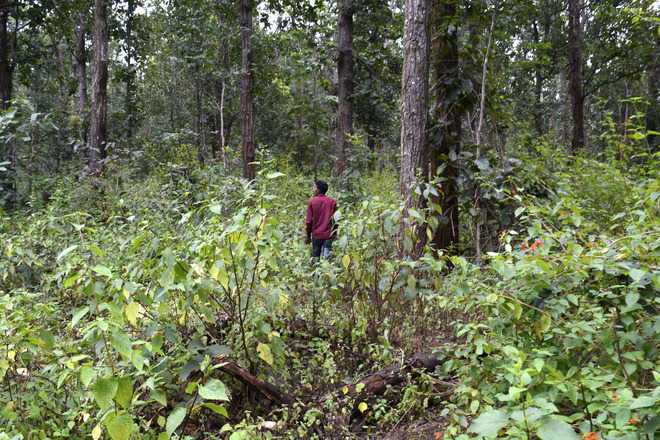
At the forefront: Villagers like Ram Prasad have taken upon themselves the responsibility of the upkeep of their forest.
Manu Moudgil
Ram Prasad pushes his spade into the soil digging around two hands deep. After a few minutes, he fishes out a clean, white tuber sans the hair usually attached to underground food. Colloquially called Dongchi Kanda, the greasy, minutely sweet root was worth the effort. “It is very good for scorpion bite as well. Tie it at the place of bite and the poison won’t spread in the body. The person can easily be taken to the healer,” Ram Prasad informs. After a short uphill climb, he digs out another tuber. This one did not require much effort and had a faint hint of turnip.
The forest around Pondi village in Baiga Chak region of Madhya Pradesh is full of such vines and tubers as well as trees of sal, mahua (Madhuca Indica) and tendu (Diospyros Melanoxylon). Mehul (Bauhinia Vahlii), the largest creeper of India, is stretched over the forest. Its large leaves, divided into two symmetrical lobes, are used to serve food or stitched to carve bowls, while its stems are entwined and strained into ropes. Till some years ago, these vines and tubers were in scarcity and all one could see was a stretch of sal trees. Thanks to villagers like Ram Prasad, who are a part of the local forest study group, the diversity has evidently come back.
Baiga Chak, an officially recognised traditional habitat of Baiga tribe, has always been known for its myriad species and their inclusion in local diet, lifestyle and healthcare. With changing times, however, the forest was losing its richness. This prompted the non-profit National Institute of Women, Child, and Youth Development (NIWCYD) to establish forest study groups in various villages of the area in 2005. The approach was unique as instead of getting experts to research on the changing ecosystem, villagers were trained to not only analyse the situation, but also suggest conservation plans through available local knowledge. In short, they were to become citizen scientists.
However, before all that, it was essential to generate a spirit of ownership among locals. “Villagers had lost connection with the jungle as they believed it belongs to the forest department, which never consults them on its management. This meant they didn’t feel the responsibility to preserve it as well. As we talked to them about how they use the forest in more ways than one, they realised the need for conservation and also asserting their right in governance,” says Balwant Rahangdale of NIWCYD.
In the process
The forest study group members interviewed village elders and documented details of 71 bird species, 56 varieties of trees, 23 types of wild vegetables, 18 types of tubers and 34 varieties of medicinal herbs along with their uses. A herbarium was also prepared for floral species. They found that bamboo, amla (Gooseberry), char (Buchanania cochinchinensis), tendu, mehul, harra (Terminelia Chebula) and many more useful species were declining.
“The study also informed us that over exploitation and faulty extraction was leading to this drop in forest quality,” says 29-year-old Kisan Lal Pasgaiyan, one of the members of the forest study group. Many villagers would cut down the whole tree instead of just taking the fruits or flowers. They would also light fire to get rid of bushes which make certain areas inaccessible. “In addition, forest department preferred sal over other species for its timber. Coupe felling or routine axing of trees by the department to encourage regrowth would also kill vines like mehul and falling trees crushed seedlings,” Pasgaiyan adds.
The study groups presented their findings in gram sabha (village council) meetings and sought suggestions from everyone. “We were able to convince people that saving the forest is in our interest. If we don’t do that it will stop providing us food, wood and medicines,” Ram Prasad adds.
Solutions to problems
What followed was a comprehensive plan to stop reckless cutting of trees and burning of forest floor. Patrols were set up and fines imposed on violators. “It still took us a couple of years to make people understand and follow sustainable practices,” Pasgaiyan says. The forest department also had to face a lot of resistance in its coupe-felling exercises. Thankfully, nature responded to such actions and several floral varieties have strengthened their hold. The basket of forest produce has also expanded. “People earn extra income by selling produce like mushrooms, mehul and tendu leaves, which have spread over a larger area, all thanks to the study and subsequent actions taken by the villagers,” says Balwant Rahangdale of NIWCYD.
Theory put into practice
The ownership villagers now feel for forest is evident from the fire-control measures they take. “Earlier people would not even put down the fire close to the village. Now many rush to extinguish the flames anywhere in the jungle,” Pasgaiyan points out. The real evidence of improved forest health comes from the status of water bodies. The two main streams, which used to dry up by April first week, now run till end of May. Many farmers have now started sowing Rabi (winter) crop of wheat and ramtilla (an oilseed), not possible earlier.
The concept of citizen science thrown up by the Baigas gains greater importance when looked in the backdrop of persistent rural to urban migration and loss of traditional knowledge with passing away of older generations. Such exercises in documentation and analysis can be a good means to not only preserve the knowledge but also benefit ecosystem-dependent occupations, including farming, fishing, and trade in minor forest produce. Considering that India is still a biomass-based country, the impact can be massive.
— This article had been done with support from the Trans Disciplinary University (TDU)-Nature India Media Fellowship.



























